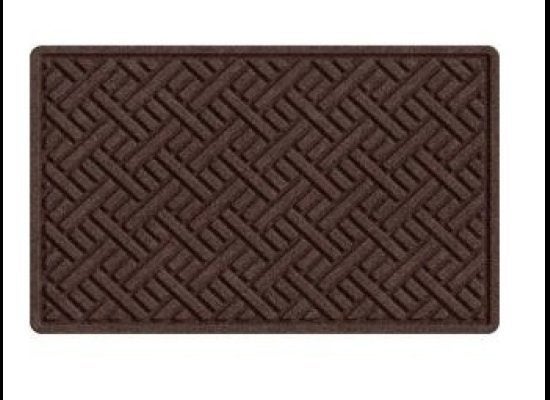We've mentioned before that the entryway is the first impression visiting guests have of your home -- so, laying down a good doormat is not only the best way to protect your floors, it's also an easy way to instantly make your foyer look organized and pulled together. On top of that, the doormat is your home's first line of defense against all the debris that might come from wet boots and shoes, so it's important to consider a mat's material and size in relation to where it will be used. We break down the essentials to look for here.
Indoor-outdoor mats. First off, consider where the doormat will be used. If it's going to be used in an outdoor area, it's important to pick a mat made from weather-resistant materials such as teak, woven seagrass or waterproof coconut fibers, which are highly durable and ideal for busy indoor-outdoor areas.
Consider the doormat surface. For mats used by outdoor entrances or high-traffic areas, look for mats with abrasive or textured surfaces. Also worth looking into: Mats that have "scraper surfaces," which are designed to whisk away even the most stubborn mud.
Avoid full-on rubber mats during winter. Although rubber doormats are cost-efficient, durable and won't slide when you wipe your shoes, it's better to keep them indoors in the garage or stowed away during wintertime. That's because the cold and prolonged exposure to the elements can cause the rubber to crack.
Keep the mat in its place. On a really muddy day, the worse thing that could happen is having the mat slip and move right out from under us. The solution? Opt for thick, non-slip backings that will keep the mat in place.
Indoor-only mats. A lot of doormats claim to be suitable for outdoor use, but you can never be too careful. Mats made from sisal, jute and fabrics (like cloth) are best used indoors, since they don't stand up well to the elements over long periods of time. Think of these mats as "transitional" -- their job is to catch any lingering debris, not to scrape off all the dirt.
Check the size. While doormats come in many sizes and shapes, it's important that it fits in size with your door. It goes without saying that both feet have to fit on the mat, but make sure that it's at least about 3/4 or 80% the width of the doorway where it will be used. Also consider height: we've all had mats that are too thick and slide or get stuck when we open a door, so keep thick mats to outdoor use.
Clean mats are more effective. A clean mat will trap more dirt and debris, so clean doormats as often as possible. For most indoor mats, all you have to do is shake them out or put a vacuum to them. Or if it's plastic fibers, wood or rubber, simply hose down the mat and air dry it.
Click through this slideshow to see some of our picks for great doormats.
